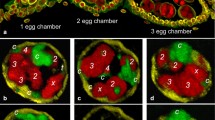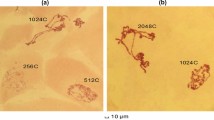Abstract
Comparisons were made of the morphology of the proximal region of the salivary gland X-chromosome of D. melanogaster following a number of different staining procedures. Azur B was found to be the most satisfactory staining method for identification of the nucleolus. The states of eu- and heterochromatization (sensu Prokofyeva-Belgovskaya) of the bands in the proximal region—particulary striking in the mirror-image duplication of the R(1)2, ring-X, chromosome—contribute to the variability in the banding-pattern, and consequently the refractoriness of this region to cytological investigation. No nucleolus was ever found to be associated with the group of bands presumed to be the Y-chromosome.
Similar content being viewed by others
References
Arcos-Terán, L., Beermann, W.: Changes of DNA replication behavior associated with intragenic changes of the white region in Drosophila melanogaster. Chromosoma (Berl.) 25, 377–391 (1968).
Barigozzi, C.: A general survey on heterochromatin. Port. Acta biol. A, R. B. Goldschmidt Vol., 593–620 (1951).
Barr, H. J., Plaut, W.: Comparative morphology of nucleolar DNA in Drosophila. J. Cell Biol. 31, C17-C22 (1966).
Bauer, H.: Structure and arrangement of salivary gland chromosomes in Drosophila species. Proc. nat. Acad. Sci. (Wash.) 22, 216–222 (1936).
Beermann, W.: Riesenchromosomen. Protoplasmatologia, Bd. VI/D, S. 1–161. Wien: Springer 1962.
Bridges, C. B.: Salivary chromosome maps. J. Hered. 26, 60–64 (1935).
—: Revised map of the salivary gland X-chromosome of Drosophila melanogaster. J. Hered. 29, 11–13 (1938).
Brown, S. W.: Heterochromatin. Science 151, 417–425 (1966).
Cooper, K. W.: Cytogenetic analysis of major heterochromatic elements (especially Xh and Y) in Drosophila melanogaster, and the theory of heterochromatin. Chromosoma (Berl.) 10, 535–588 (1959).
Darlington, C. D., La Cour, L. F.: The Handling of Chromosomes, 4th ed. London: George Allen & Unwin, Ltd. 1962.
Emmons, C. W.:The morphology of the nucleus in the salivary glands of four species of Drosophila (D. melanogaster, D. immigrans, D. funebris and D. subobscura. Z. Zellforsch. 26, 1–20 (1937).
Frolova, S.: Struktur der Kerne in den Speicheldrüsen einiger Drosophila-Arten. [Russian and German summary.] Biol. Zhurn. 5, 271–292 (1936).
—: Development of the giant nuclei of salivary gland type in different organs of Drosophila and their comparison with “metabolic” nuclei of larvae and imago. Biol. Zhurn. 7, 703–736 (1938).
Gall, J. G., Cohen, E. H., Polan, M. L.: Repetitive DNA sequences in Drosophila. Chromosoma (Berl.) 33, 319–344 (1971).
Gay, H.: Chromosome structure and function. Carnegie Inst. Washington, Yearbk. 62, 501–510 (1963).
Griffen, A. B.: The obscure parts of the X chromosome in Drosophila melanogaster. Genetica 36, 105–113 (1965).
Hannah, A.: Radiation-mutations involving the cut locus in Drosophila. Proc. 8th Intern. Congr. Genet. Hereditas (Lund.), Suppl., 588–589 (1949).
—: Environmental factors affecting elimination of the ring-X chromosome in Drosophih melanogaster. Z. indukt. Abstamm.- u. Vererb.-L. 86, 600–621 (1955).
Hannah-Alava, A.: Cytogenetics of nucleolus-transpositions in Drosophila melanogaster. Molec. gen. Genet. 113, 191–203 (1971).
Heitz, E.: Über α- und β-Heterochromatin sowie Konstanz und Bau der Chromomeren bei Drosophila. Biol. Zbl. 54, 588–609 (1934).
Kaufmann, B. P.: The nucleolus-organizer regions in salivary gland chromosomes of Drosophila melanogaster. Z. Zellforsch. 28, 1–11 (1938).
—: Induced chromosome rearrangements in Drosophila melanogaster. J. Hered. 30 179–190 (1939).
Kroeger, H.: Microsurgery on cells with polytene chromosomes. In: Methods in cell physiology (D. M. Prescott, ed.) vol. 2, p. 61–92. NewYork: Academic Press 1966.
Lindsley, D. L., Grell, E. H.: Genetic Variations of Drosophila melanogaster. Carnegie Inst. Wash. Publ. No 627 (1968).
Murgatroyd, L. B.: Some salient points in the preparation of a new methyl green pyronin stain and use in cytology and histology. Mikroskopie 18, 285–287 (1963).
Nash, D., Plaut, W.: On the presence of DNA in larval salivary gland nucleoli in Drosophila melanogaster. J. Cell Biol. 27, 682–686 (1965).
Nicoletti, B., Lindsley, D. L.: Translocations between the X and Y chromosomes of Drosophila melanogaster, Genetics 45, 1705–1722 (1960).
Painter, T. S.: The morphology of the X-chromosome in salivary glands of Drosophila melanogaster and a new type of chromosome map for this element. Genetics 19, 448–469 (1934).
—, Stone, W.: Chromosome fusion and speciation in Drosophila. Genetics 20, 327–341 (1935).
Pelling, C.: Ribonukleinsäure-Synthese der Riesenchromosomen. Autoradiographische Untersuchungen an Chironomus tentans. Chromosoma (Berl.) 15, 71–122 (1964).
Prokofyeva-Belgovskaya, A. A.: The structure of the Y-chromosome in the salivary glands of Drosophila melanogaster. Genetics 22, 94–103 (1937).
—: Heterochromatization as a change in the chromosome cycle. (Russian with English summary.) Biol. Zhurn. 62, 93–124 (1945).
—: Heterochromatization as a change of chromosome cycle. J. Genet. 48, 80–98 (1947).
Ritossa, F. M., Spiegelman, S.: Localization of DNA complementary to ribosomal RNA in the nucleolus organizer region of Drosophila melanogaster. Proc. nat. Acad. Sci. (Wash.) 53, 737–745 (1965).
Rodman, T. C.: Morphology and replication of intranucleolar DNA in polytene nuclei. J. Cell Biol. 42, 575–582 (1969).
Rudkin, G. T.: The structure and function of heterochromatin. In: Genetics Today. Proc. XI Intern. Congr. Genetics 1963 (S. J. Geerts, ed.) vol 2, p. 359–374. Oxford: Pergamon Press 1965.
Schultz, J., Catcheside, D. G.: The nature of closed X-chromosomes in Drosophila melanogaster. J. Genet. 35, 315–320 (1938).
Slizynski, B. H.: Deficiency effects of ultra-violet light in Drosophila melanogaster. Proc. roy. Soc. (Edinb.) 61B, 297–315 (1942).
Sorsa, M.: Ultrastructure of the chromocentre heterochromatin in Drosophila melanogaster. Ann. Acad. Sci. fenn. A-IV, 146, 1–20 (1969).
Swift, H.: Cytochemical techniques in nucleic acids. In: Nucleic acids (E. Chargaff and J. N. Davidson, eds.) vol. 2, p. 51–92. New York: Academic Press 1955.
Tiniakov, G. G.: The inert regions and general morphology of the chromosomes in the salivary gland cells of Drosophila. Biol. Zhurn. 5, 753–802 (1936).
Vincent, W. S., Miller Jr., O. L. (eds.): Intern. Symp.: The nucleolus, its structure and function. Nat. Cancer Inst. Monogr. 23 (1966).
Warters, M., Griffen, A. B.: The centromeres of Drosophila. Genetica 30, 152–167 (1959).
Wimber, D. E., Steffensen, D.: Localization of 5 S RNA genes on Drosophila chromosomes by RNA-DNA hybridization. Science 170, 639–641 (1970).
Author information
Authors and Affiliations
Additional information
This investigation was supported in part by a U.S. Public Health Service Research Grant, GM 15009, from the Institute of General Medical Sciences of the National Institutes of Health, and in part by a grant from the Finnish National Research Council for Sciences.
Rights and permissions
About this article
Cite this article
Viinikka, Y., Hannah-Alava, A. & Arajärvi, P. A reinvestigation of the nucleolus-organizing regions in the salivary gland nuclei of Drosophila melanogaster . Chromosoma 36, 34–45 (1971). https://doi.org/10.1007/BF00326420
Received:
Accepted:
Issue Date:
DOI: https://doi.org/10.1007/BF00326420




